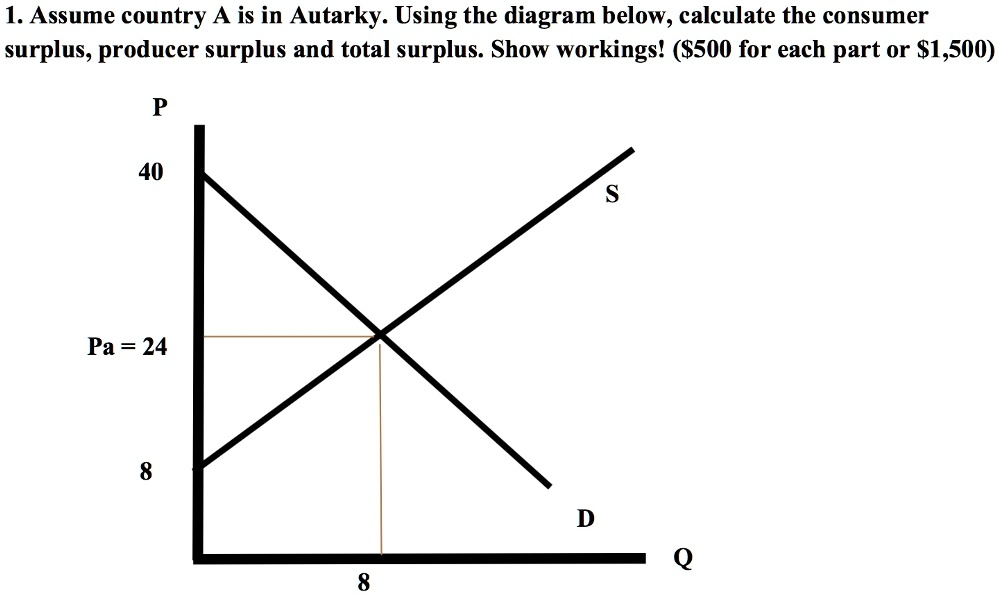Assume country A is in Autarky

The Correct Answer and Explanation is:
Of course. Here are the calculations for consumer surplus, producer surplus, and total surplus based on the provided diagram, along with a detailed explanation.
Calculations
1. Consumer Surplus (CS)
Consumer surplus is the area of the triangle below the demand curve and above the equilibrium price (Pa = 24).
- Formula: CS = 0.5 * base * height
- Workings:
- Base = Equilibrium Quantity = 8
- Height = Maximum Price (P-intercept of Demand) – Equilibrium Price = 40 – 24 = 16
- CS = 0.5 * 8 * 16
- CS = 4 * 16
- Answer: Consumer Surplus = $64
2. Producer Surplus (PS)
Producer surplus is the area of the triangle above the supply curve and below the equilibrium price (Pa = 24).
- Formula: PS = 0.5 * base * height
- Workings:
- Base = Equilibrium Quantity = 8
- Height = Equilibrium Price – Minimum Price (P-intercept of Supply) = 24 – 8 = 16
- PS = 0.5 * 8 * 16
- PS = 4 * 16
- Answer: Producer Surplus = $64
3. Total Surplus (TS)
Total surplus is the sum of consumer surplus and producer surplus.
- Formula: TS = Consumer Surplus + Producer Surplus
- Workings:
- TS = $64 + $64
- Answer: Total Surplus = $128
Explanation
The problem asks to calculate the economic surplus in Country A, which is in a state of autarky. Autarky means the country is economically self sufficient and does not engage in international trade. Therefore, the market equilibrium is determined solely by domestic supply and demand.
The provided diagram shows the supply (S) and demand (D) curves for a good in this country. The point where these two curves intersect represents the market equilibrium. According to the graph, the autarky equilibrium price (Pa) is $24, and the equilibrium quantity is 8 units.
Consumer surplus represents the total benefit or value that consumers receive beyond what they pay for a good. It is calculated as the area between the demand curve and the equilibrium price line. This area forms a triangle. The base of this triangle is the equilibrium quantity (8), and its height is the difference between the highest price consumers are willing to pay (the demand curve’s intercept at
40)andthepricetheyactuallypay(40)andthepricetheyactuallypay(24). The calculation (0.5 * 8 * 16) results in a consumer surplus of $64.
Producer surplus represents the total benefit that producers receive beyond their costs of production. It is the area between the supply curve and the equilibrium price line. This area is also a triangle. Its base is the equilibrium quantity (8), and its height is the difference between the price producers receive ($24) and the lowest price they are willing to accept (the supply curve’s intercept at $8). The calculation (0.5 * 8 * 16) yields a producer surplus of $64.
Total surplus, also known as economic welfare, is the sum of consumer and producer surplus. It measures the total net benefit to society from the production and consumption of the good. By adding the consumer surplus (
64)andtheproducersurplus(64)andtheproducersurplus(64), we find the total surplus is $128. This value represents the maximum possible welfare for this country’s market in the absence of trade.
